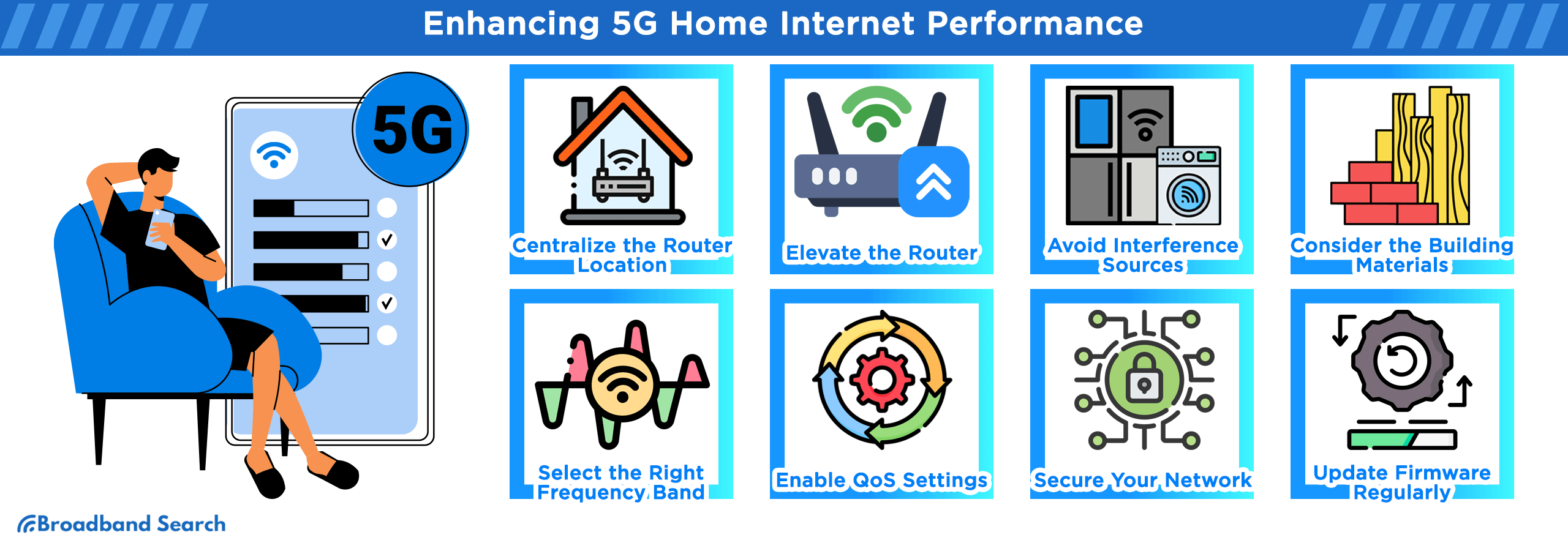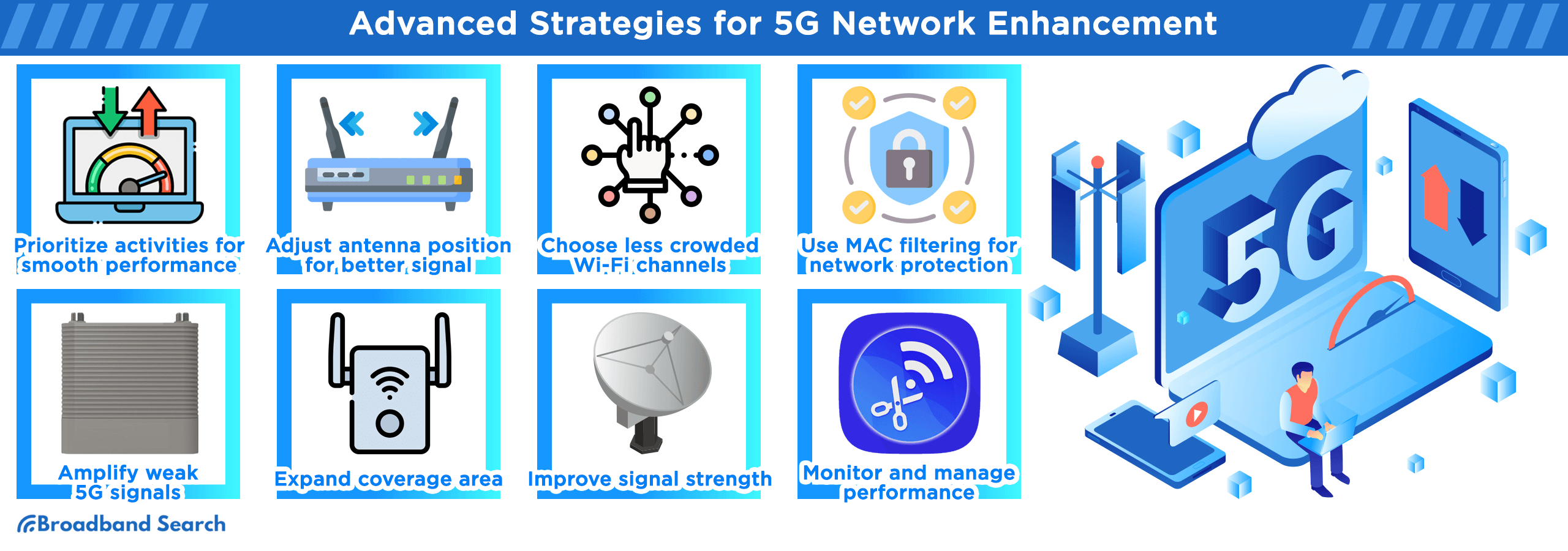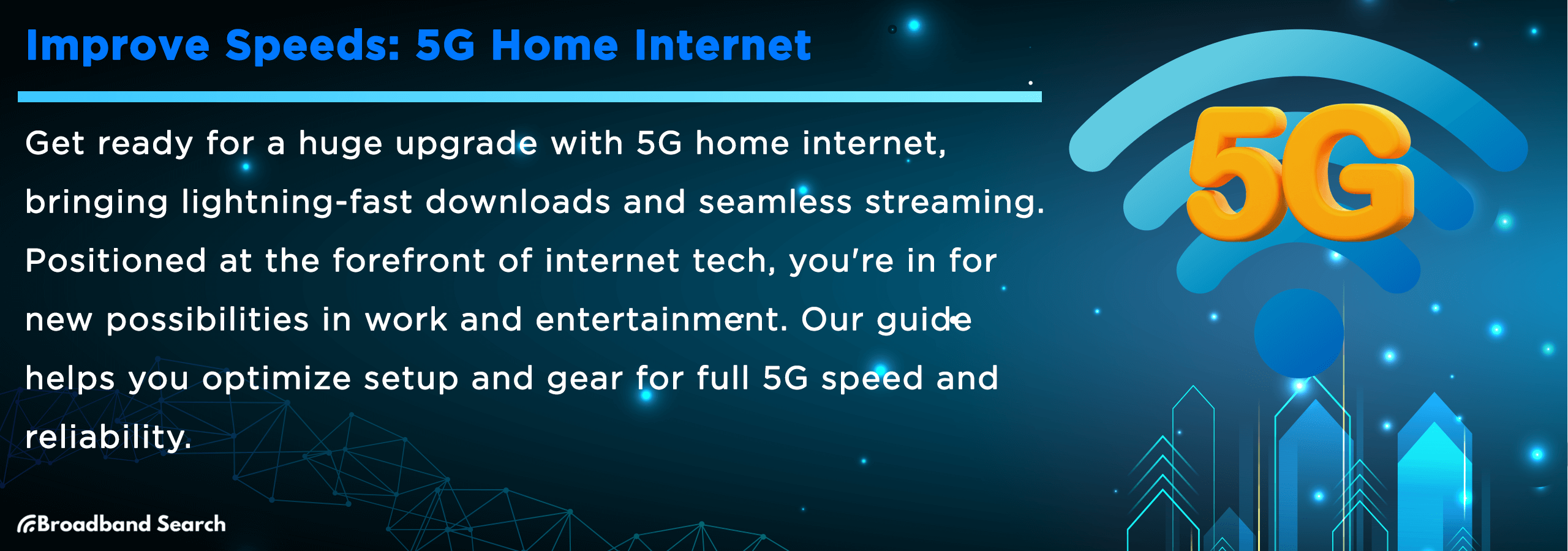As we step into the future with 5G home internet, your online experience is about to get a significant upgrade. This technology isn't just a step up from previous generations; it's a leap into a realm of lightning-fast downloads and seamless streaming. You're now at the forefront of internet technology, unlocking new possibilities in work, entertainment, and everyday digital interactions.
But how do you make the most of this cutting-edge technology? In this guide, you'll discover key strategies to enhance your 5G home internet speeds. From optimizing your setup to choosing the right equipment, we'll guide you through the 5G landscape, ensuring you enjoy the full speed and reliability this technology has to offer.
The Significance of High-Speed 5G in Home Environments
The Role of High-Speed Internet in Modern Living
- Enabling Remote Work and Learning: The increased bandwidth, faster speeds, and low latency of 5G are transforming the way we approach remote work and learning. This technology enables tasks that were previously challenging due to slower speeds, such as downloading huge files or participating in high-definition video conferencing, to be completed efficiently from virtually anywhere.
- Advancing Smart Home Technology: 5G's high speed and efficiency are pivotal in advancing smart home devices. With its low latency and high-band frequencies, 5G supports more users on the same network, enhancing the performance of smart home security systems, and making the home smarter overall.
- Revolutionizing Entertainment: The low latency and high speed of 5G are perfect for VR and AR experiences. This means more immersive gaming, where actions and reactions in the game happen in real-time, and a more seamless AR experience, where digital information is overlaid on the real world without delay. For example, VR gaming can now happen with much less lag, making the experience more realistic and enjoyable.
- Facilitating IoT and Emerging Technologies: Its low latency and expanded networks allow it to reach significantly more devices per square kilometer than 4G, with speeds up to ten times faster. This leap forward is not just about a better network; it's about a new "cloud-native" network that can support a wide range of IoT applications, from fully connected cars to smart grids covering entire cities, and telehealth for a new age of healthcare.
Comparing 5G with Traditional Broadband
- Speed of 5G vs Traditional Home Broadband: 5G internet offers significantly faster speeds compared to traditional home broadband connections. While broadband connections can vary in speed depending on the plan, 5G has the potential to provide multi-gigabit speeds, which is a considerable leap forward.
- Accessibility and Coverage: The coverage and accessibility of 5G internet compared to home broadband present notable differences. Currently, 5G deployment is primarily concentrated in urban areas, with these regions being the first to experience its roll-out. In contrast, home broadband boasts a more extensive coverage footprint, reaching more consistently into suburban and rural locations.
- Network Flexibility and Efficiency: 5G networks support advanced features like network slicing, allowing the creation of multiple virtual networks over a single physical infrastructure. This capability enables tailored services for specific needs, such as dedicated networks for emergency services or businesses. Additionally, 5G's service-based architecture supports more efficient use of network resources, enhancing overall performance.
Setting Up for Maximum 5G Efficiency

As we embrace the transformative potential of 5G technology in our homes, setting up for maximum efficiency is key to fully leveraging its capabilities. This involves not just choosing the right equipment, but also understanding the nuances of 5G networking.
Selecting Appropriate 5G Equipment
- Compatibility with Service Provider: It's crucial to choose a 5G modem and router that are compatible with your service provider's network. This includes checking that the devices can connect to the specific 5G frequencies (like sub-6 GHz and mmWave) used by your provider.
- Performance Specifications: Look for modems and routers that can handle the high speeds offered by 5G networks. While 5G networks promise speeds up to 10 Gbps, real-world usage often sees average speeds closer to 100 Mbps. Nonetheless, choose equipment capable of supporting these higher speeds for future-proofing your setup.
- Flexibility: Choose routers with versatile deployment options, allowing for placement in a variety of settings to maximize signal reach. This flexibility is especially crucial in expansive enterprise environments where traditional network setup locations might not suffice for optimal signal distribution.
- Additional Features and Security: Choosing routers with robust security, including VPN, firewalls, IDS/IPS, and content filtering, is crucial. Zero-trust principles and network slicing further enhance protection, especially in networks with many devices or enterprise settings. Security features are also vital to protect your network from unauthorized access.
Identifying Reasons for Sluggish 5G Connectivity
To address sluggish 5G connectivity and investigate the causes of unstable 5G speeds, it's crucial to understand and address various factors that lead to inconsistent 5G performance. These factors include:
- Network Congestion: Like any network, 5G can suffer from congestion, especially in densely populated areas where many devices are competing for bandwidth. During peak usage times, you might experience slower speeds.
- Distance from 5G Cell Towers: The further you are from a 5G cell tower, the weaker the signal strength, which can significantly impact your internet speed. Buildings, trees, and other physical obstructions can also affect signal strength.
- Interference from Household Electronics: Certain household electronics, like microwaves, cordless phones, and even baby monitors, can interfere with your 5G signal, leading to reduced speeds and connectivity issues.
- Outdated or Inadequate Equipment: Utilizing old routers or devices not designed for 5G can negatively impact your network's efficiency. To fully leverage 5G's capabilities, it's crucial to equip yourself with compatible and current technology. Experts suggest updating your router approximately every five years to maintain optimal performance.
Enhancing 5G Home Internet Performance

Enhancing the performance of your 5G home internet is essential for a seamless and efficient online experience. With the rapid advancement of 5G technology, ensuring optimal connectivity within your home can lead to faster speeds, reduced latency, and more reliable internet access.
Strategic Router Placement
- Centralize the Router Location: Placing your router in a central location within your home can significantly improve coverage. This ensures that the signal reaches all areas of your house more evenly, reducing dead spots.
- Elevate the Router: Elevating the router, ideally on a high shelf or mounted on a wall, can enhance its signal range. This is because the Wi-Fi signals tend to spread outwards and downwards, and elevating the router helps in better signal distribution.
- Avoid Interference Sources: Keep the router away from devices and appliances that can cause interference, such as microwaves, cordless phones, and even large metal objects. These can disrupt the Wi-Fi signal, leading to weaker connectivity.
- Consider the Building Materials: The materials used in your home's construction can affect Wi-Fi signal strength. Materials like concrete, brick, and metal can block or weaken signals. Try to place the router in a location that minimizes these obstructions, especially in relation to where you most frequently use the internet.
Configuring Your Network for Optimal 5G Use
- Select the Right Frequency Band: Most modern routers offer dual or tri-band capabilities, including 2.4 GHz and 5 GHz bands. The mid-band spectrum, ranging from 1 GHz to 6 GHz, is often regarded as ideal for 5G due to its capacity to transmit substantial amounts of data across considerable distances.
- Enable Quality of Service (QoS) Settings: QoS allows you to prioritize internet traffic for specific devices or applications. This is particularly useful for activities that require a lot of bandwidth, like streaming or gaming, ensuring they get the necessary resources without interruption.
- Secure Your Network: An unsecured network can lead to unauthorized access, which not only poses a security risk but can also slow down your internet speed. Use strong, unique passwords, enable WPA3 encryption, and consider hiding your network SSID for added security.
- Update Firmware Regularly: Manufacturers frequently release firmware updates that can improve your router's performance and security. Ensure your router's firmware is up to date to take advantage of these improvements and keep your network running smoothly.
Advanced Strategies for 5G Network Enhancement

Detailed Network Tuning for Better 5G
- Adjusting Bandwidth Allocation: Managing bandwidth allocation is essential in optimizing 5G network performance. By prioritizing bandwidth for high-demand activities such as video streaming, gaming, or large file transfers, you can ensure these applications run smoothly.
- Optimizing Antenna Settings: The placement and orientation of your 5G router's antennas can significantly impact the strength and stability of your connection. Adjusting the antennas to ensure they are correctly positioned can help enhance signal reception and distribution throughout your space. This might involve positioning them perpendicular to each other or ensuring they're not obstructed by physical barriers.
- Channel Optimization: Channel optimization involves selecting the least congested channel for your 5G network. This can be particularly effective in environments with many overlapping networks, like apartment complexes. Tools and apps are available to analyze Wi-Fi channels in your area, like NetSpot, allowing you to choose a channel with minimal interference, thereby improving your network's performance.
- Advanced Security Settings: Implementing advanced security settings like MAC address filtering can significantly enhance your network's security. This feature allows you to prevent traffic coming from other devices, adding an extra layer of protection against unauthorized access. This is especially useful in preventing unknown devices from using your network and potentially slowing it down.
Utilizing Additional Tools and Accessories
- 5G Signal Boosters: These devices amplify the 5G signal in your home, especially useful in areas with weak 5G coverage or where physical obstructions impact signal strength. They work by capturing existing signals, boosting them, and rebroadcasting the enhanced signal.
- Wi-Fi Extenders and Mesh Systems: Wi-Fi extenders expand the coverage area of your Wi-Fi network by receiving the existing signal and retransmitting it. Mesh systems, on the other hand, consist of multiple router-like units that work together to blanket your entire home with a strong Wi-Fi network. They are particularly effective in large spaces where a single router's coverage is insufficient.
- High-Gain Antennas: Replacing standard antennas on your router with high-gain antennas can improve signal strength and range. These antennas focus the signal in specific directions, which can be particularly beneficial in multi-story homes or longer spaces.
- Network Analyzers and Management Apps: These tools, like NetCut, help you monitor and manage your network's performance. They can provide insights into signal strength, network usage, and potential interference sources. Many of these apps also offer suggestions for optimizing your network setup for better performance.
Maintaining and Troubleshooting 5G Networks
Resolving Typical 5G Home Internet Issues
Resetting Your Equipment
- Power Off Your 5G Device: Turn off your 5G modem or router.
- Wait: Leave it off for at least 30 seconds. This allows the device to reset.
- Power On: Turn the device back on and wait for it to fully restart. This process can take a few minutes.
- Reconnect: Check if your devices can now connect to the internet.
Checking for Signal Interference
- Identify Potential Sources: Common interference sources include microwaves, Bluetooth devices, and cordless phones.
- Relocate Your Equipment: Move your 5G modem/router away from these devices.
- Check for Physical Obstructions: Walls, furniture, or other large objects can block or weaken the signal. Consider a more central location for your modem/router.
Updating Network Drivers and Firmware
- Check for Updates: Visit the manufacturer's website for your 5G device to find the latest firmware and driver updates.
- Download and Install Updates: Follow the provided instructions to update your device. This may require a direct connection via Ethernet cable.
- Restart the Device: After updating, restart your device to ensure the new updates are properly implemented.
Testing with Different Devices
- Connect Different Devices: Try connecting various devices (like a smartphone, laptop, or tablet) to your 5G network.
- Identify Pattern: Determine if the issue is with a specific device or with all devices. This can help pinpoint whether the problem is with the network or a particular device.
- Device-Specific Troubleshooting: If only one device is having issues, the problem may be with the device's wireless adapter or settings.
Ongoing Maintenance for Reliable 5G Performance
- Regular Firmware Updates: As previously mentioned, but worth reiterating due to its significance, keeping your router and other network devices updated with the latest firmware is essential. Manufacturers frequently release firmware updates that serve multiple purposes: they enhance security measures, improve overall performance, and address known bugs and issues. It's advisable to regularly check for these updates or, if your device offers this feature, enable automatic updates.
- Monitoring Network Health: Regularly monitor your network’s health using network management tools or built-in router software. These tools can provide insights into network traffic, signal strength, and potential issues that may need your attention.
- Maintaining Optimal Router Placement: The placement of your router can significantly impact your network's performance. Ensure that your router is positioned in an ideal location — centrally located, elevated, and away from obstructions and sources of interference. Periodically reevaluate this placement, especially if there are changes in your home layout or new electronic devices are added.
- Scheduled Performance Checks: Set a routine schedule to test your network's performance. This includes checking internet speeds, assessing Wi-Fi coverage, and identifying any connectivity issues. Regular checks allow you to address any emerging problems before they become significant.
Future-Proofing Your Home 5G Network
Keeping Your Network Future-Ready
- Investing in Scalable Hardware: Choose network hardware that can scale with technological advancements. Look for routers and other devices that support the latest standards and have the capability to handle increased speeds and connections. Devices with the flexibility to upgrade firmware or add new features via software updates are particularly valuable.
- Staying Informed About Technological Advances: Keep abreast of the latest developments in 5G technology. This can include subscribing to tech news feeds, following industry leaders on social media, or participating in tech forums. Being aware of upcoming trends and technologies allows you to make informed decisions about when to upgrade or adjust your setup.
- Flexible Network Configuration: Opt for a network setup that can be easily reconfigured or expanded. Solutions like mesh network systems are inherently flexible, allowing you to add more nodes to improve coverage or adapt to changing home layouts.
- Embracing Cloud Services: Cloud services are increasingly integral to home networks, offering benefits like enhanced security, remote access, and automatic updates. Utilizing cloud-based management tools like Cradlepoint NetCloud Manager for your network can provide advanced features and ensure your system stays up-to-date with the latest security protocols and performance enhancements.
Final Thoughts
5G technology stands out for its dynamic nature and the promise of continuous evolution. Its introduction into home internet is just the beginning of a broader technological revolution. With speeds that surpass traditional broadband and a latency that supports even the most demanding online activities, 5G is poised to redefine our concept of connectivity.
In essence, embracing 5G home internet is not just about enjoying faster speeds today; it's about being part of a rapidly advancing digital landscape. As users, staying informed and adaptable to these technological shifts is crucial. By doing so, we position ourselves to make the most of these innovations, ensuring an improved and more efficient online experience both now and in the future.
FAQ
What is 5G home internet?
5G home internet is a wireless internet service that leverages the fifth generation of mobile network technology (5G) to provide high-speed internet connectivity. It's known for faster speeds, lower latency, and more reliable connections compared to its predecessors like 4G. Unlike traditional broadband that requires physical cables, 5G internet uses cellular network technology to deliver internet access.
Is 5G home internet available in rural areas?
The availability of 5G home internet in rural areas varies based on the region and the presence of 5G infrastructure. While urban areas are often the first to receive 5G services due to higher population density, many service providers are progressively expanding their 5G networks to include rural and remote locations. However, coverage can still be limited in some rural areas.
How does weather affect 5G home internet connectivity?
Indeed, weather conditions can impact a 5G signal. Precipitation such as rain and snow, along with severe weather, can disrupt the transmission of high-frequency 5G signals. This interference can result in signal weakening, leading to diminished performance and effectiveness of the connection.
Can I use my existing devices with 5G home internet?
Most modern devices that are capable of connecting to a Wi-Fi network can use 5G home internet. However, to fully utilize the speeds and features of 5G, devices specifically designed for 5G connectivity (like certain smartphones or routers) are recommended. It's important to check if your devices are compatible with the specific 5G network frequency bands used by your service provider.
Can I upgrade my existing broadband to 5G home internet?
Upgrading from existing broadband to 5G home internet is possible, but it depends on the availability of 5G services in your area and the specific requirements of the 5G network. This upgrade usually involves getting a new 5G-compatible router and subscribing to a 5G internet plan from a service provider. It's advisable to contact your internet service provider for detailed information regarding the upgrade process and compatibility requirements.

